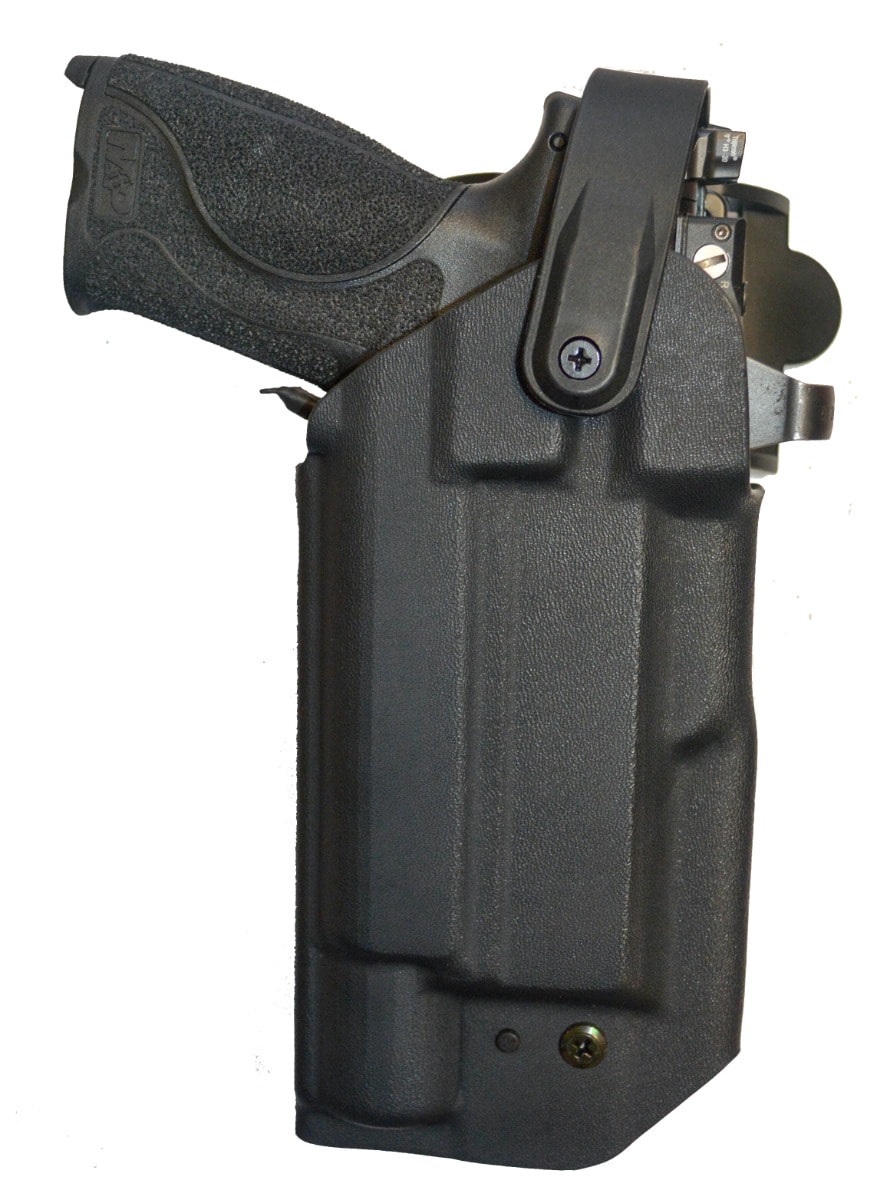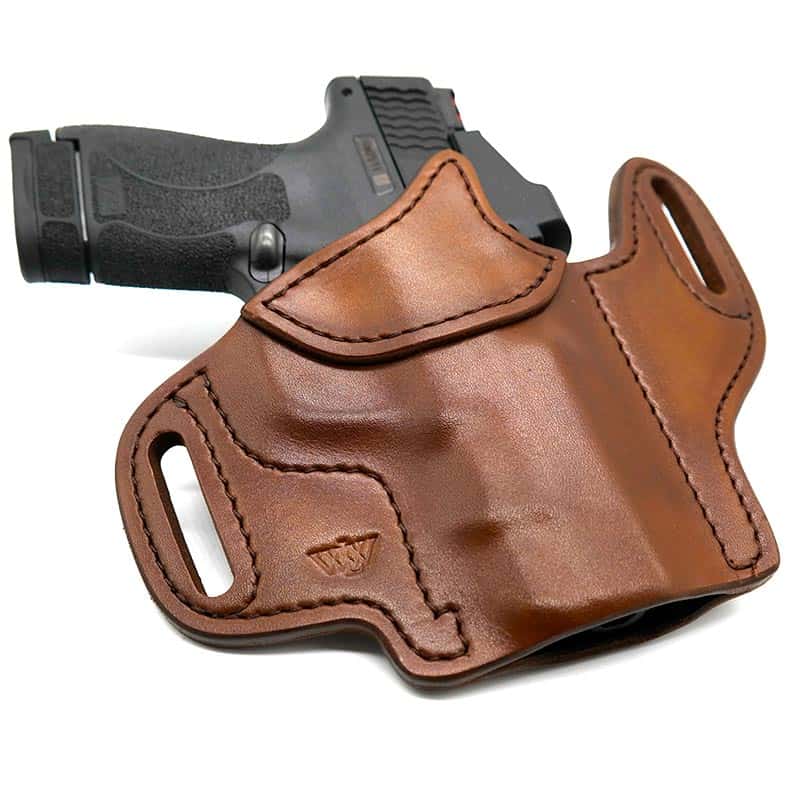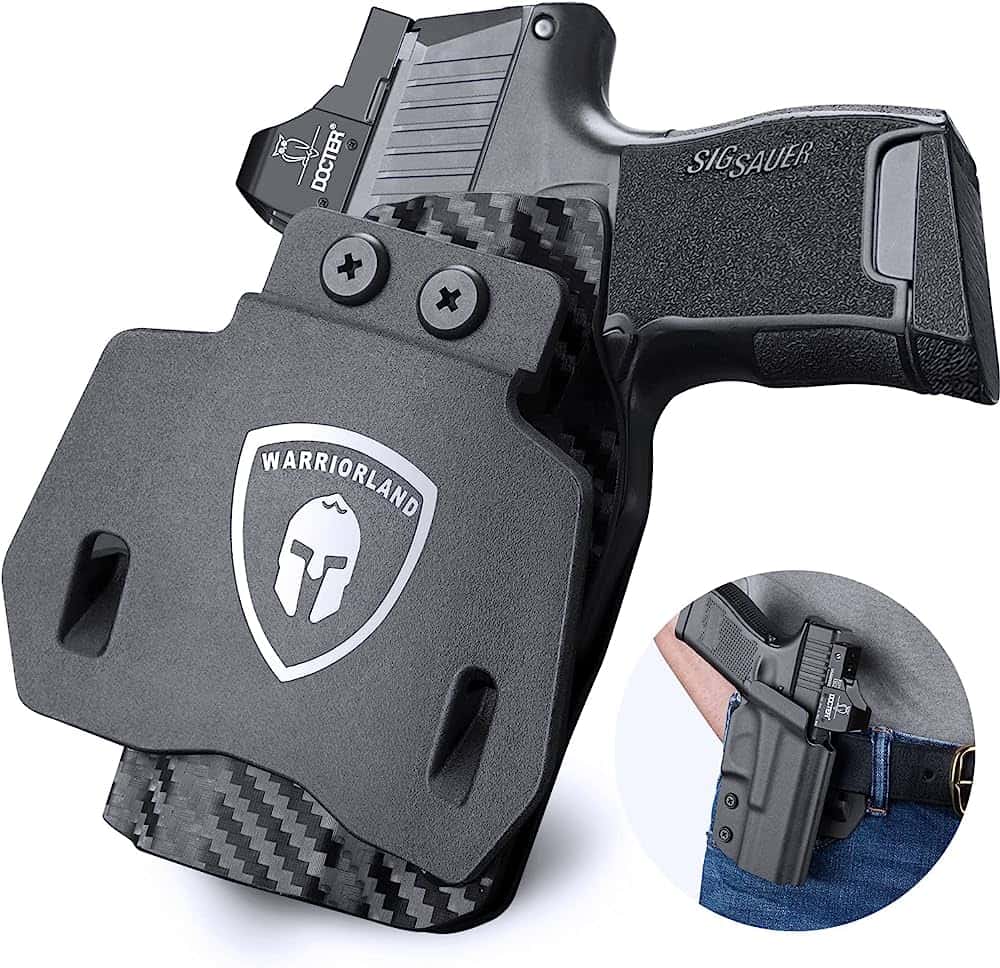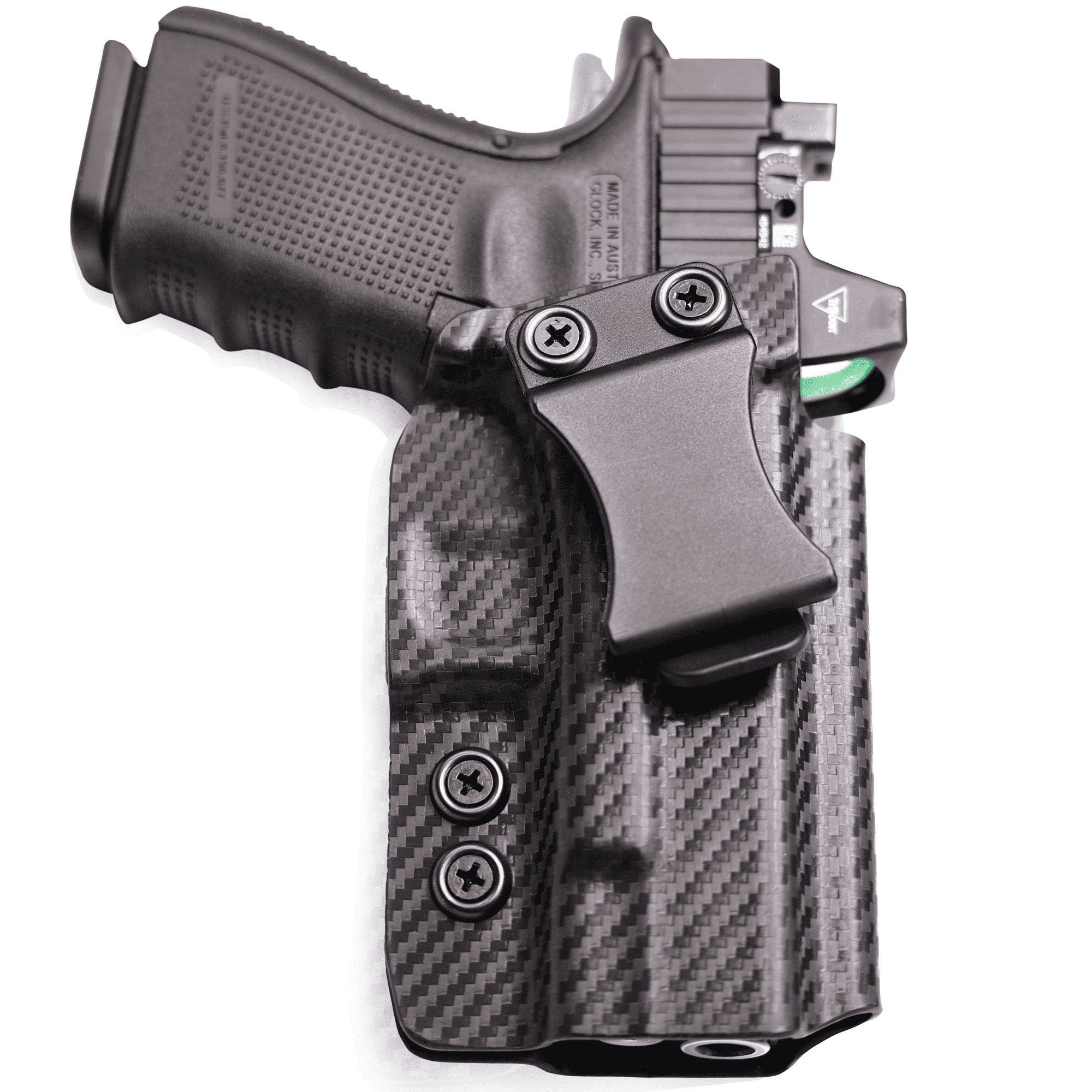Contents
- 1. Introduction to Holstering with Optics
- 2. Understanding Red Dot Sights and Scopes
- 3. Benefits of Using Red Dot Sights and Scopes with Holsters
- 4. Factors to Consider When Choosing a Holster for Optics
- 5. Different Types of Holsters Designed for Optics
- 6. Proper Holstering Techniques for Red Dot Sights and Scopes
- 7. Maintenance and Care Tips for Holstering with Optics
- 8. Frequently Asked Questions about Holstering with Red Dot Sights and Scopes
- 1. Can I use any holster with a red dot sight or scope?
- 2. Will the red dot sight or scope affect the draw speed?
- 3. What are some advantages of using a holster designed for optics?
- 4. Are there any specific considerations when choosing a holster for concealed carry with an optic?
- 5. Can I use my existing holster by modifying it myself?
- 6. How do I properly maintain my holstered firearm with optics?
- 7. Can I use a holster designed for a red dot sight with a scope?
- 8. Are there any safety concerns related to using holsters with optics?
1. Introduction to Holstering with Optics

Holstering a firearm equipped with optics, such as red dot sights or scopes, presents a unique set of challenges and considerations for gun owners. As the popularity of these optical enhancements continues to grow, it becomes increasingly important to understand how to properly accommodate them in holsters.
When it comes to holster selection, one must take into account the added dimensions and potential protrusions caused by optics. Unlike traditional iron sights, which rest low on the slide or barrel, optics can extend above the firearm’s profile. This necessitates finding a holster specifically designed for accommodating such accessories.
The benefits of using optics on firearms are numerous. They provide faster target acquisition and improved accuracy, especially in dynamic shooting scenarios. However, these advantages come with the need for specialized equipment that can secure both the firearm and its associated optic safely.
One option is choosing a dedicated holster designed specifically for firearms equipped with optics. These holsters often feature adjustable Retention Systems that allow users to customize the fit according to their specific setup. Additionally, they may employ sight channels or cutouts that prevent interference between the optic and holster during draw strokes.
Another consideration is ensuring proper protection for your optic while holstered. Optics are delicate instruments prone to damage from impacts or debris ingress if not adequately shielded during carry. Therefore, selecting a holster that provides adequate coverage around the optic area is crucial in maintaining its longevity and functionality.
Furthermore, comfort plays an essential role when carrying concealed weapons outfitted with optics all day long. The added bulk of an optic-equipped handgun might impact comfort levels significantly if not taken into account when choosing a holster design suitable for extended wear periods.
In conclusion, incorporating red dot sights or scopes into your everyday carry setup requires careful consideration when selecting an appropriate holster solution tailored specifically for this purpose. By prioritizing compatibility with your chosen optic model along with factors like retention, protection, and comfort, you can ensure a secure and optimized holstering experience. Now let’s delve into some frequently asked questions regarding holsters for optics-equipped firearms.
2. Understanding Red Dot Sights and Scopes

Red dot sights and scopes are essential accessories for firearm enthusiasts, providing enhanced accuracy and target acquisition. Whether you’re a beginner or an experienced shooter, understanding the basics of red dot sights and scopes can greatly improve your shooting experience.
The Purpose of Red Dot Sights
Red dot sights are optical devices that use a small illuminated dot as the aiming point. Unlike traditional iron sights, which require aligning the front and rear sight posts, red dot sights allow shooters to focus on the target while placing the red dot on it. This simplifies aiming and reduces eye strain.
How Do Red Dot Sights Work?
Red dot sights utilize LED technology to project a reticle onto a special lens in front of your eyes. The reticle appears as a bright red dot or another shape of your choice (e.g., crosshair). These devices are parallax-free, meaning that the position of your eye doesn’t affect the aim point. This makes them ideal for quick target acquisition in dynamic shooting scenarios.
Types of Red Dot Sights
There are different types of red dot sights available on the market today:
1. Reflex Sight: The most common type, reflex sights have an open design with an illuminated reticle projected onto a single lens.
2. Holographic Sight: These advanced optics use holographic technology to display reticles that appear more three-dimensional compared to reflex sights.
3. Tube Sight: Tube-style red dots have enclosed bodies with lenses at both ends for added protection against environmental factors like dust or rain.
4. Prism Sight: Similar to tube-style optics but with fixed magnification levels, prism sights offer greater precision at longer distances.
5. Miniature Reflex Sight (MRDS): Compact in size and lightweight, MRDSs are often used for handguns or as secondary optics on rifles.
Choosing the Right Scope
When it comes to scopes, there are a few factors to consider:
1. Magnification: Determine your shooting needs and choose a scope with an appropriate magnification level. Higher magnifications are suitable for long-range shooting, while lower magnifications are better for close-quarters engagements.
2. Objective Lens Diameter: The larger the objective lens diameter, the more light enters the scope, resulting in brighter images with improved clarity.
3. Reticle Type: Scopes offer various reticles such as duplex, mil-dot, or BDC (bullet drop compensator). Select a reticle that aligns with your shooting preferences and intended use.
4. Durability: Look for scopes made from rugged materials like aircraft-grade aluminum and equipped with weatherproof features to withstand harsh conditions.
Understanding red dot sights and scopes is crucial for any shooter looking to enhance their accuracy and speed. By selecting the right optic that suits your needs and understanding how they work, you can take your shooting skills to new heights. So next time you hit the range or head out on a hunting trip, make sure you’re armed with all the necessary knowledge about these essential accessories!
3. Benefits of Using Red Dot Sights and Scopes with Holsters

When it comes to firearms accessories, red dot sights and scopes have become increasingly popular among shooters of all skill levels. These optical enhancements provide a range of benefits that can greatly improve shooting accuracy and overall performance. When combined with holsters, the advantages are further enhanced, making them an excellent choice for any serious shooter.
Improved Target Acquisition
The primary advantage of using red dot sights and scopes with holsters is the improved target acquisition they offer. These optics provide a clear aiming point on the target, allowing shooters to quickly and accurately align their shots. With a red dot sight or scope attached to your firearm in a holster, you can easily acquire targets in various lighting conditions and at different distances.
Enhanced Accuracy
Achieving pinpoint accuracy is crucial for any shooter, whether on the range or in self-defense scenarios. Red dot sights and scopes help enhance accuracy by eliminating guesswork when it comes to aiming. By placing a red dot sight or scope on your firearm while holstered, you gain better control over shot placement due to increased visibility of your target.
Rapid Target Transition
In dynamic shooting situations where targets appear suddenly or move rapidly, quick target transition is essential. Red dot sights and scopes allow for faster target acquisition compared to traditional iron sights alone. When combined with holsters designed specifically for these optics, shooters can seamlessly draw their firearms from concealment without wasting precious time acquiring targets.
Better Low-Light Performance
Shooting under low-light conditions can be challenging without proper equipment. Fortunately, many red dot sights come equipped with illumination settings that enable shooters to see their reticle clearly even in dimly lit environments. When used in conjunction with holsters, shooters can confidently rely on their optics to perform optimally regardless of lighting conditions.
Increased Versatility
Red dot sights and scopes are versatile accessories that can be used across various firearm platforms. By utilizing holsters specifically designed to accommodate these optics, shooters can easily switch between different firearms without the need for additional adjustments or modifications. This versatility allows for greater flexibility during training sessions or competitions.
In conclusion, the benefits of using red dot sights and scopes with holsters are undeniable. These optical enhancements provide improved target acquisition, enhanced accuracy, rapid target transition, better low-light performance, and increased versatility. Whether you’re a competitive shooter or someone who values self-defense preparedness, investing in a quality red dot sight or scope along with a compatible holster will undoubtedly elevate your shooting experience.
4. Factors to Consider When Choosing a Holster for Optics

1. Compatibility with Optics
When selecting a holster for your firearm equipped with optics, it is crucial to ensure compatibility between the two. Not all holsters are designed to accommodate red dot sights and scopes, so it’s essential to choose a model that specifically caters to this requirement. Look for holsters that offer sufficient space and clearance for the added height of your optics without compromising security or functionality.
2. Retention System
The retention system of a holster plays a vital role in keeping your firearm secure while allowing quick access when needed. When considering holsters for optics, opt for models that provide adjustable retention mechanisms tailored specifically for firearms equipped with red dot sights or scopes. This ensures proper fit and retention while preventing accidental dislodging during movement or physical activity.
3. Draw Speed and Accessibility
In high-stress situations, every second counts when drawing your firearm equipped with optics. Therefore, it is crucial to choose a holster that allows quick and easy access to your weapon without any hindrances caused by the presence of optics on top of the slide or barrel. Look for holsters that offer an open-top design or incorporate features such as thumb breaks or retention straps positioned in a way that doesn’t obstruct optic-equipped firearms’ draw speed.
4. Adjustability
Given the varying sizes and configurations of red dot sights and scopes available in the market today, finding a holster with adjustable features becomes essential when accommodating different types of optics on your firearm securely. Look out for adjustable tension screws, straps, or customizable inserts within the holster design itself so you can make necessary adjustments based on the specific dimensions of your optic.
5. Comfort and Concealment
While ensuring proper functionality and security, it is equally important to consider the comfort and concealability of your holster. Optics can add bulk to your firearm, potentially impacting how comfortably and discreetly you can carry it. Look for holsters that offer ergonomic designs, padded or sweat-resistant backings, and options for different carrying positions to find one that meets both your comfort requirements and allows for effective concealed carry.
6. Quality and Durability
Investing in a high-quality holster built with durability in mind is essential, especially when accommodating optics on your firearm. Optics may introduce additional weight or create points of contact that could cause wear or potential damage over time if not properly supported by a sturdy holster. Consider holsters made from durable materials such as Kydex or reinforced nylon to ensure long-lasting performance even under rigorous conditions.
By considering these factors when choosing a holster for optics-equipped firearms, you can ensure you find the perfect combination of functionality, security, comfort, and durability tailored specifically to accommodate red dot sights and scopes effectively. Remember always prioritize safety by investing in quality products designed with precision engineering to provide reliable performance when it matters most.
5. Different Types of Holsters Designed for Optics
1. OWB (Outside the Waistband) Holsters
OWB holsters are designed to be worn outside the waistband, offering easy access to your firearm and op
2. IWB (Inside the Waistband) Holsters
iwb holsters are concealed carry options that allow you to keep your firearm and optic inside your waistband, providing better discretion. These holsters are usually made of soft materials like leather or Kydex, which offer comfort while securely holding your weapon and optic close to your body.
3. Appendix Carry Holsters
Appendix Carry holsters are specifically designed for carrying firearms with optics in front of the body around the appendix area. They provide quick access to both your gun and optic while maintaining a low-profile appearance.
4. Shoulder Holsters
Shoulder holsters are an alternative option for those who prefer carrying their firearms with optics under their arm instead of on their hip or waistline. These holsters consist of straps that go over one shoulder and across the chest, allowing you to comfortably carry both your firearm and optic with ease.
5. Drop Leg Holster
Drop leg holsters attach around the thigh area using adjustable straps, providing an accessible location for carrying firearms with optics lower on the body than traditional hip-mounted options like OWB or IWB styles.
Whether you choose an OWB holster for open carry purposes or prefer a more discreet IWB option, it’s crucial to select a holster specifically designed for accommodating optics. Optics require additional clearance and protection, ensuring secure retention and easy access to your firearm when you need it most.
Remember to prioritize comfort, accessibility, and reliability when selecting a holster for your optic-equipped firearm. With the right holster, you can confidently carry your weapon while keeping the sight picture clear for quick target acquisition in any situation.
6. Proper Holstering Techniques for Red Dot Sights and Scopes
1. Position the Firearm Correctly
When holstering a firearm equipped with a red dot sight or scope, it is crucial to position the firearm correctly. Ensure that the muzzle is pointed in a safe direction and maintain control over the weapon at all times. This will help prevent any accidental discharges and ensure your safety during the holstering process.
2. Clear Any Obstructions
Before holstering a firearm with optics, make sure there are no obstructions that could interfere with its placement. Check for any loose clothing, debris, or other objects near or inside the holster that could impede smooth insertion of the weapon. Removing these obstructions will allow you to draw and re-holster your firearm effortlessly.
3. Engage Safeties (if applicable)
If your particular firearm has any manual safeties, engage them before attempting to holster it with optics attached. This extra precautionary step ensures that your weapon is secure within its housing and reduces the risk of accidental discharge while holstered.
4. Utilize Support Hand Assistance
When inserting a handgun equipped with red dot sights or scopes into its holster, it can be helpful to use your support hand for assistance. By gripping both sides of the slide and applying gentle pressure towards your body as you guide it into place, you can ensure smooth insertion without causing any damage to either the optic or your holstered gun.
5. Maintain Visual Contact
Throughout the entire process of holstering your firearm equipped with optics, it is essential to maintain visual contact between both hands involved in securing it into place safely. By keeping an eye on both hands’ movements simultaneously, you can avoid accidentally catching any part of your optic or holster with your fingers, reducing the risk of damage.
6. Practice and Familiarize Yourself
Proper Holstering Techniques for red dot sights and scopes require practice and familiarity. Spend time practicing the process with an unloaded firearm until you feel comfortable and confident in your ability to successfully holster it without any hesitation or missteps. This regular practice will help build muscle memory, ensuring a smooth and efficient draw-and-holster motion when it matters most.
Remember, always prioritize safety first when handling firearms equipped with red dot sights or scopes. By following these proper holstering techniques, you can maintain the integrity of your optics while ensuring safe storage of your weapon.
7. Maintenance and Care Tips for Holstering with Optics
1. Regularly Inspect the Holster
To ensure your holster is in good condition, it’s important to inspect it regularly. Check for any signs of wear or damage that could compromise the security and protection of your optics. Look out for cracks, loose stitching, or any other issues that may affect the functionality of the holster.
2. Clean Your Holster Properly
Cleaning your holster is essential to maintain its quality and prolong its lifespan. Use a mild soap solution and a soft cloth to gently wipe down the surface of the holster, removing any dirt or debris that may have accumulated over time. Avoid using harsh chemicals or abrasive materials as they can damage both the holster material and your optics.
3. Store Your Holster in a Safe Place
When you’re not using your holstered firearm with optics, make sure you store it in a safe place away from extreme temperatures, humidity, and direct sunlight. Optics can be sensitive to these environmental factors which may lead to potential damage or malfunctioning.
4. Be Mindful During Reholstering
When reholstering your firearm with optics attached, exercise caution to avoid accidental scratches or bumps on the optic lens or body. Take your time while inserting it into the holster ensuring that there is no contact between sharp edges of either component.
5. Choose a Compatible Holster Design
Selecting an appropriate holster specifically designed for accommodating red dot sights and scopes can significantly reduce potential risks during everyday use as well as provide optimal retention and security for both components.
By following these maintenance tips diligently, you can ensure that both your holstered firearm and attached optics remain protected while also extending their overall lifespan.
8. Frequently Asked Questions about Holstering with Red Dot Sights and Scopes
1. Can I use any holster with a red dot sight or scope?
No, not all holsters are designed to accommodate red dot sights or scopes. It is important to choose a holster specifically made for this purpose. These holsters usually have an open-top design or adjustable retention system to ensure a proper fit.
2. Will the red dot sight or scope affect the draw speed?
Using a red dot sight or scope may slightly impact the draw speed initially, as it requires acquiring the target through the optic. However, with practice and training, you can become proficient in quickly aligning your sights and improving your overall draw speed.
3. What are some advantages of using a holster designed for optics?
Holsters designed for optics offer several advantages such as enhanced comfort due to their custom fit, increased security and retention of your firearm equipped with an optic, and improved accessibility during quick-draw situations.
4. Are there any specific considerations when choosing a holster for concealed carry with an optic?
When selecting a concealed carry holster for use with an optic, it is crucial to ensure that the holster provides adequate concealment without printing excessively. Additionally, consider factors like comfort, adjustability options, and ease of drawing from concealment.
5. Can I use my existing holster by modifying it myself?
While it might be tempting to modify your current holster to accommodate an optic attachment yourself, we highly recommend against doing so unless you have professional expertise in such modifications. It’s best to invest in a purpose-built holster that ensures optimal functionality and safety.
6. How do I properly maintain my holstered firearm with optics?
To maintain your holstered firearm with optics, regularly inspect and clean both the optic and the holster. Ensure that there is no debris or obstruction that could hinder your draw or damage the optic. Additionally, follow the manufacturer’s guidelines for cleaning and maintenance of your specific optic model.
7. Can I use a holster designed for a red dot sight with a scope?
Holsters specifically designed for red dot sights may not accommodate scopes due to their different dimensions and mounting mechanisms. It is advisable to use holsters specifically made for scopes to ensure a secure fit and proper functionality.
While using holsters with optics does not pose direct safety concerns, it is crucial to ensure that the holster provides adequate protection of the trigger guard area to prevent accidental discharges. Always prioritize safe handling practices when using firearms equipped with optics.
Remember, choosing the right holster designed for red dot sights or scopes ensures optimal performance, convenience, and safety while carrying your firearm equipped with these attachments.

Brian Belko is a freelance writer and blogger. His primary areas of focus include the outdoors and shooting sports. In addition to his freelance work, Brian also writes for Wide Open Spaces and is on the Pro Staff at Military Hunting and Fishing. When he isn’t busy writing, Brian enjoys fishing farm ponds for bass and hitting the spring woods during turkey season.
